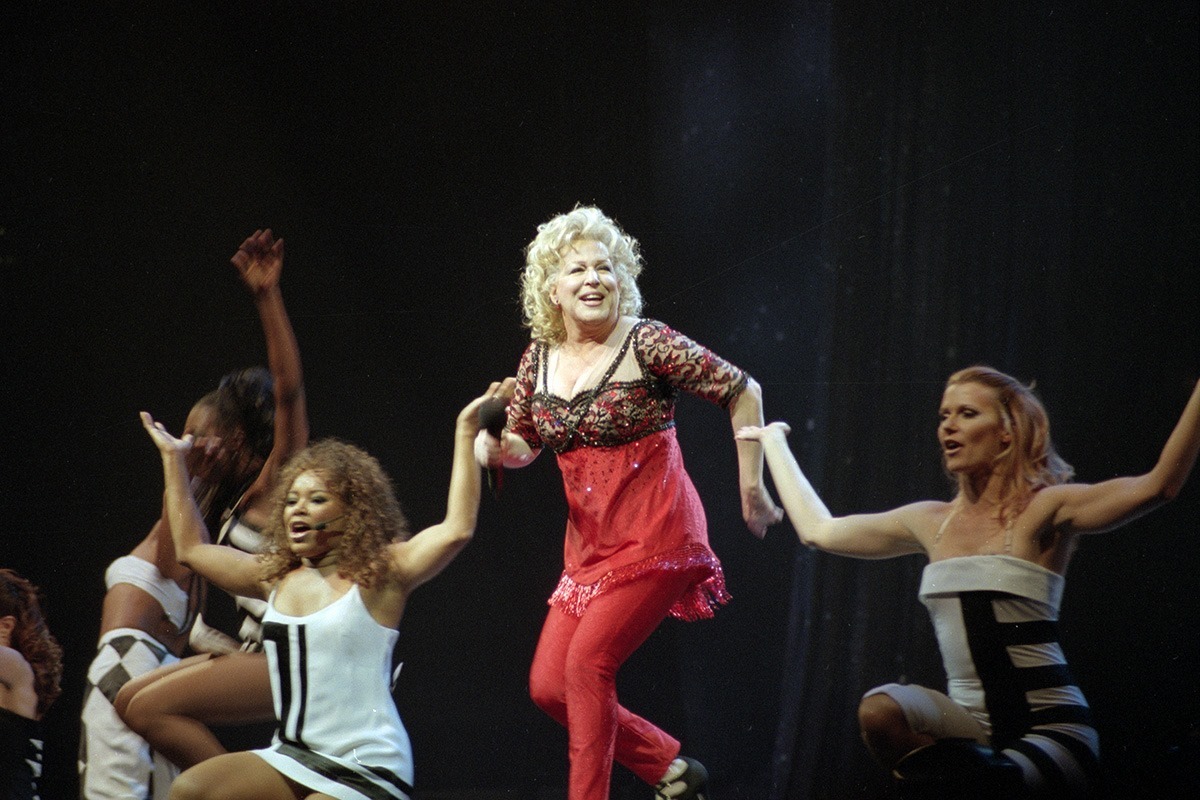This story is the second part of a two-part series on the legendary Vancouver live music venue the Cave. Read the first part here.
It’s hard to quantify the full extent of Rob Frith’s collection of memorabilia—to say nothing of his other contributions to Vancouver’s music scene.
As the proprietor of Neptoon Records—“Vancouver’s oldest independent record store,” founded in 1981—Frith, with the Vancouver Record Collectors Association, has put out several albums’ worth of local music, including vintage Vancouver acts like the Northwest Company and the Nocturnals. He’s appeared with Michael Willmore on the cable-access music show Rockinitis, hosted in-store music events ranging from a concert by Jack White’s band the Raconteurs to a signing by Eric Burdon, and was featured in the Museum of Vancouver’s exhibit devoted to collectors and their collections (“If the objects you collect are cool, then it’s not hoarding,” he once said).
Asked about his most memorable nights at Vancouver’s iconic club the Cave (whose stories we began chronicling in Part 1 of this series, When Tina Turner, the Who’s Drummer, and the Temptations Played the Cave, and Other Tales From Vancouver’s Legendary Club), he doesn’t hesitate. Hands down that had to be James Brown and Bette Midler.
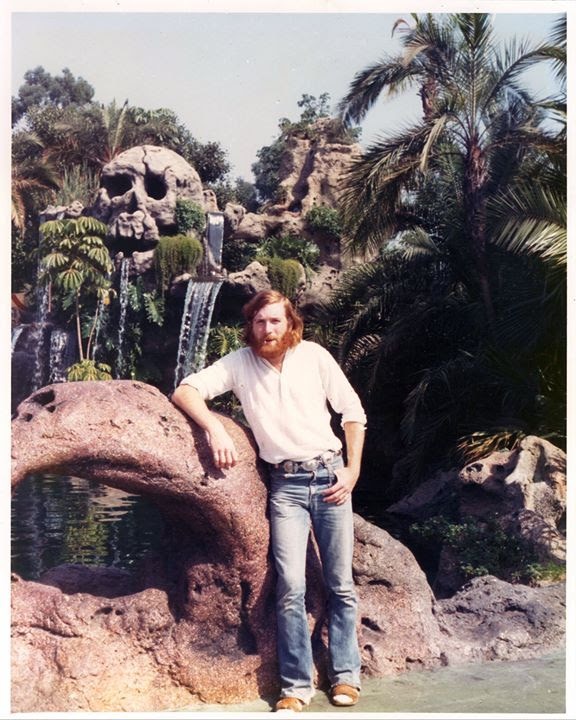
Rob Frith around the time he would have gone to the Cave (1980). Photo by Vicki Frith.
How Frith got in to see James Brown, the year before Neptoon opened, is in many ways the high point of his story. “I was a big fan of the R&B Allstars, and the singer, Hans Staymer, had this great voice that always kind of reminded me of Tom Waits.” Frith was such a big Waits fan that in the 1970s, he’d spent time in LA visiting “all the haunts that he’d sung about in his songs, like the Ivar Theatre and all these different restaurants.”
Having decided that Staymer would be a natural to sing Waits’ song “Whistlin’ Past the Graveyard,” Frith reached out to a member of the R&B Allstars through a mutual friend and offered to drop off the music so they could have a listen. “So I went to his place, and he thanked me—I don’t think he’d heard of Tom Waits at this point. And then he said, ‘Oh, I got two free tickets for James Brown at the Cave,’ that night or the next night, I can’t remember.”
Frith gladly took the tickets and went to the show, and brought his wife, Vicki, with him. They sat in the balcony, and the room, he says, was “incredible. You walked in the Cave and you felt like you were somewhere special. It looked like this giant cave, with stalactites coming down, but it was a big place; it was not like going to some basement in some hotel somewhere or some square-box venue. You felt like you were goin’ out.”
James Brown’s band was “just insanely good,” Frith recalls. “I’d never seen them before. I can’t remember if it was before or after, but—do you know the guy that puts the cape around James Brown at the end of the shows, usually? It’s a shtick that they do; James Brown falls to his knees, and it’s like he can’t do another thing, and this guy puts a cape around him and tries to lead him off the stage. The guy that does that came up to our table with this really big guy, probably a security guard with them on their tour, and they’ve got these black-and-white photos of James Brown. And they come to the table with the attitude that you’re going to buy some of these photos. I remember being a little bit intimidated! It wasn’t like they were being, like, salesmen. It’s like, ‘Here’s the photos, and we expect you to buy these.’ So we bought some!”
The evening progressed, and a few drinks later, Frith looked over at the next table, “and there’s James Brown sitting right at the next table to us. And I was just so in awe, just so blown away that James Brown would be sitting right next to us. What I found out later was, the dressing room or some kind of backstage area was up there in the balcony, and the door was right next to that table. That was as close as I got to meeting James Brown. I was too afraid to go say hi because back then I was too shy.”
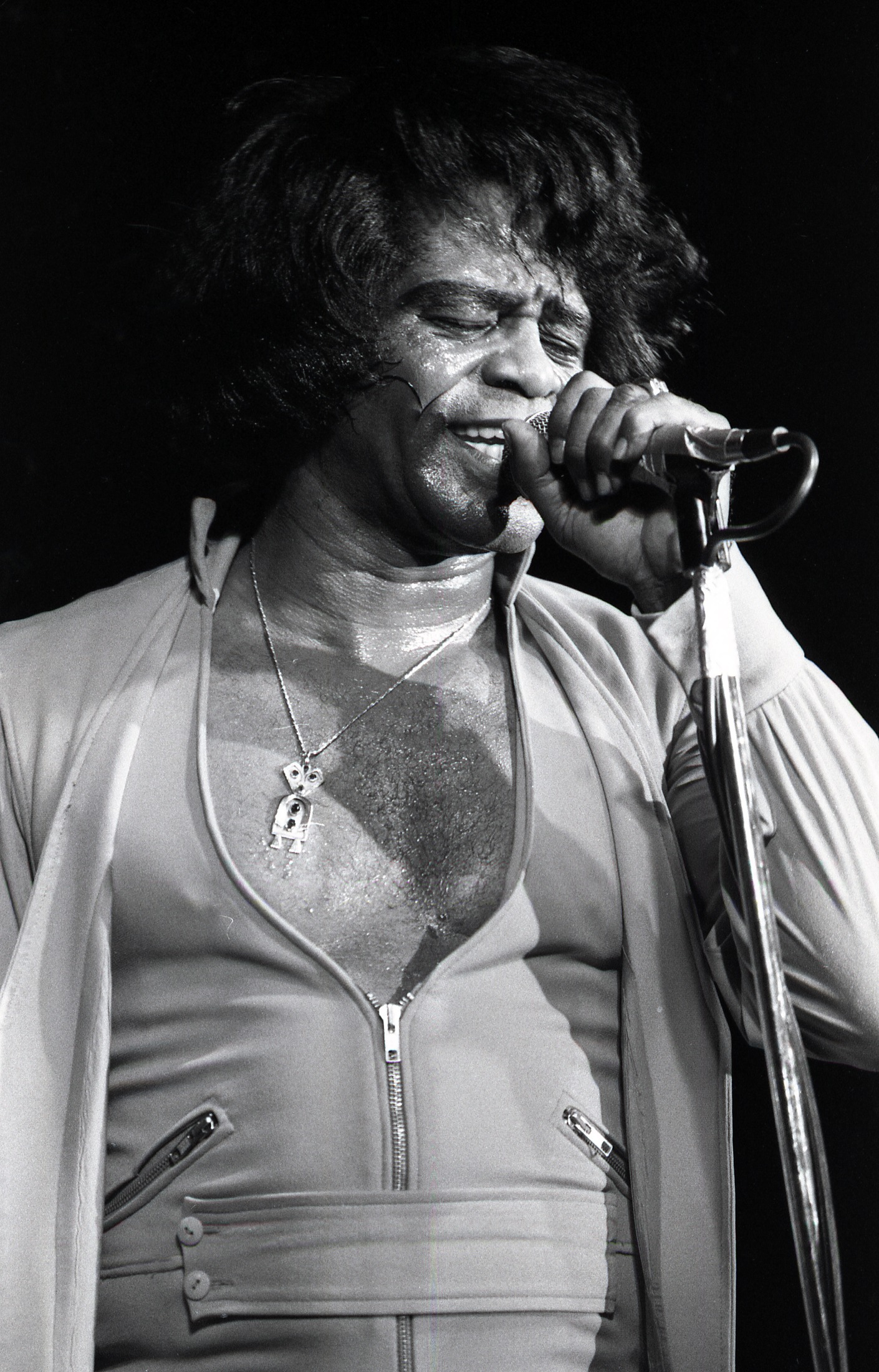
James Brown at the Commodore, March 5, 1985. Photo by Bev Davies.
It was Vicki who, a few years previous, circa 1977, had gotten Rob to go to see Bette Midler. “I remember thinking it was such an unbelievable show. I had never really been to a Vegas-type thing before then. I know now, from going to Vegas things after, that this was like, way more laid back, but so professional, so impressive. She cracked dirty jokes and did this whole Sophie Tucker thing. Tucker had done a lot of risqué stuff in the ’40s or ’50s and was a big influence on her.”

Bette Midler ticket stub. Courtesy of Rob Frith.
David M., the founding member of caustic, folky pop satirists No Fun—known locally as “the Beatles of Surrey”—was also in the audience that night. “Nothing was out of bounds with her,” he remembers of Midler. “She exemplified every kind of show business—she had this rock edge to her, not just on the albums but live; she could do that kind of stuff, as well as straight-up showbiz schmaltz. And she was known for her raunchiness. It was something you couldn’t really put in movies; there was no real outlet for it other than your finer supper clubs and dinner venues, where people got a kick out of that.”
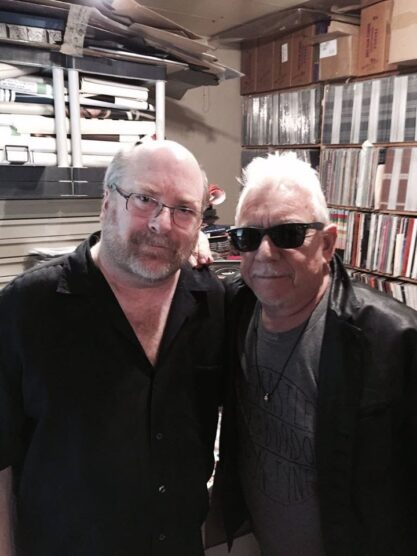
Rob Frith with Eric Burdon, Record Store Day 2015. Photo by Vicki Frith.
More impressive to Rob Frith was that Midler “was doing jokes about stuff that happened in Vancouver. Like, she mentioned a politician’s name, and she made a crack about Surrey and stuff like that. Really great stuff—it was just amazing that someone would come into town and know everything about Vancouver. I was so impressed that she would be so on top of her game to have researched that.
“Anyway, I found out years later, there’s this famous writer, his name is Bruce Vilanch, and he’s written for everyone.” Vilanch had had a long association with Midler—even co-writing her feature film Divine Madness—and is still active doing stand-up and cameos in everything from You Don’t Mess With the Zohan (where he’s chilling with George Takei) to The Simpsons. “He was following ahead of them on the tour and reading the newspaper and talking to people and writing the material,” Frith says, “and two days later he would give her the material, and she’d memorize it. That’s why it worked so well.”
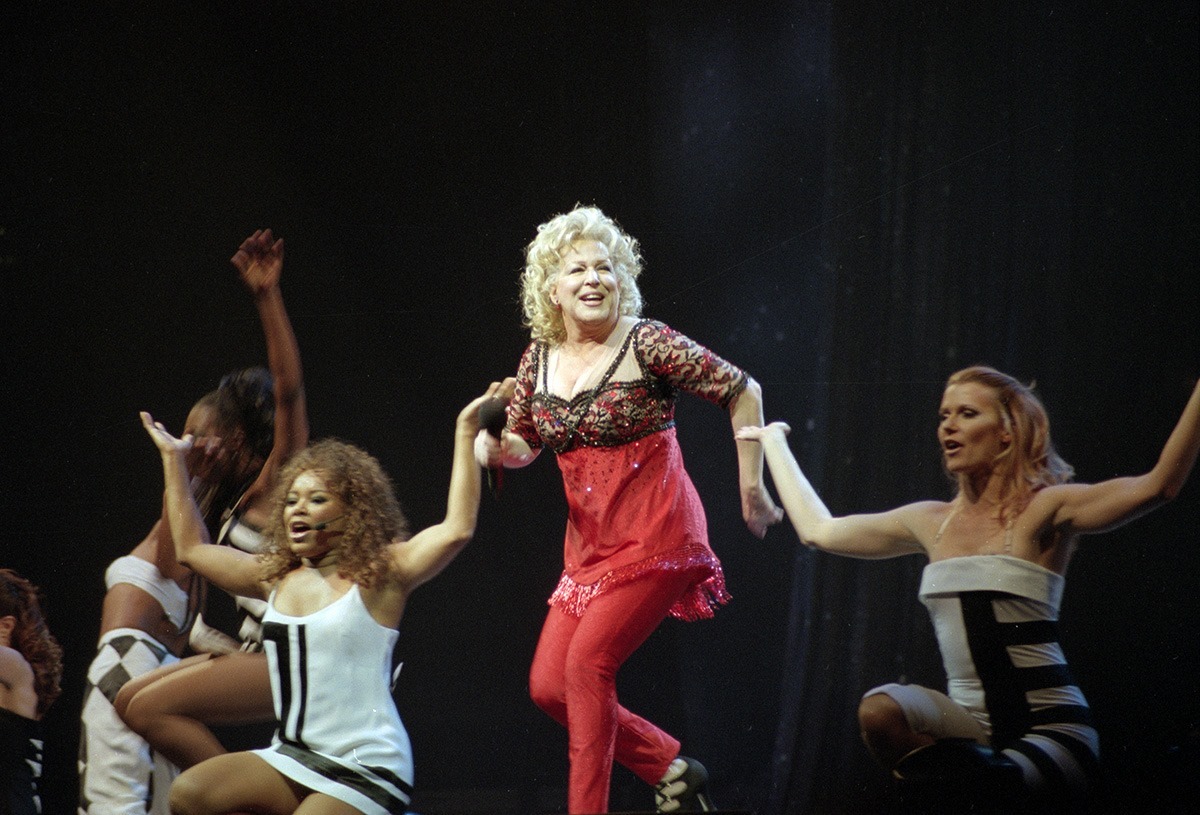
Bette Midler at GM Place, 1999. Photo by Kevin Statham.
The other vivid memory of the performance was something that Frith says Midler has only done a couple of times. “The audience was so good on the night we were there—and she played quite a few nights, I think—that she got so carried away that she actually flashed her boobs at the audience. It was just one of those crazy nights when just everything worked, the jokes were great. It was relaxed, cool, funny, incredible music, incredible vocals, the backup band was insanely good. It was like a giant house party, almost. You kind of felt like you were part of the thing.”
David M. remembers Midler’s show being “very loose and very funny and impeccably produced, on every level. That to me is the best kind of show, where it’s not just knockin’ them out, the same show every time. That is the show business ideal I’ve always had, where something is undeniably what it is, but it is also authentic on every level, and also, anything-can-happen.”
“To me, seeing Iggy and the Stooges at Pender Auditorium, just around the corner from there, a couple of years earlier, and seeing Bette Midler at the Cave have that in common,” he continues. “You’re seeing the real thing: It’s on a stage, but it’s hardly staged. You’re just getting this impression of a real, authentic, gifted performer who might just do anything. And seeing her there was much better than seeing her anywhere else. It was a place made for someone like her.”
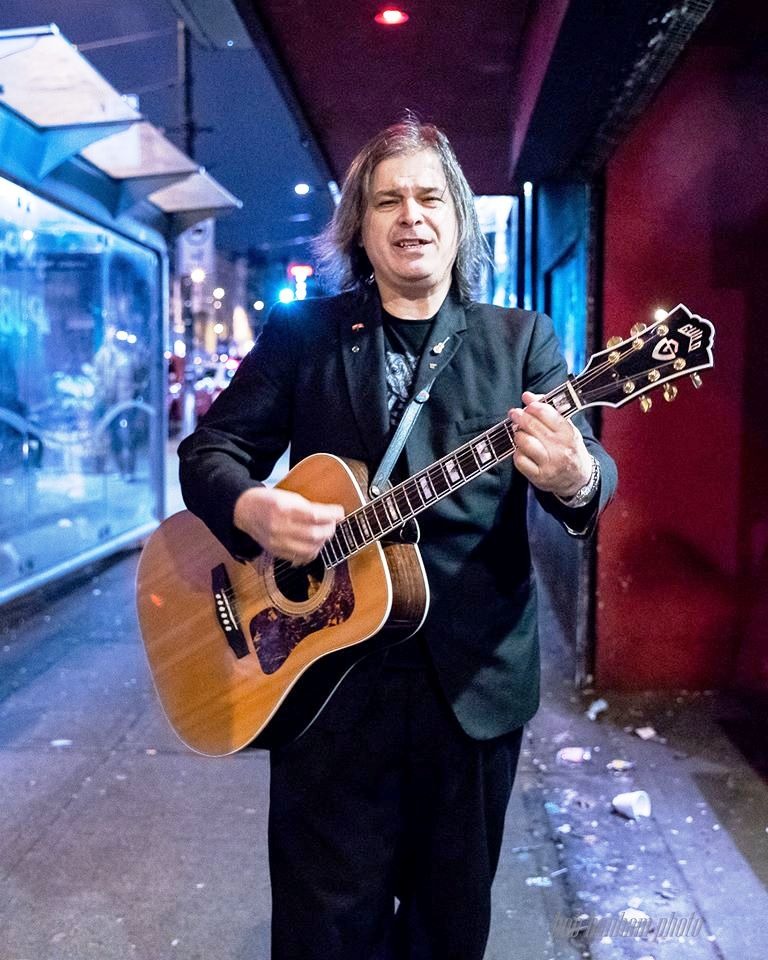
David M. outside the 2020 Bowie Ball at the Rickshaw Theatre. Photo by Bob Hanham.
No Fun, the Beatles of Surrey, take the stage at the Cave
Sometime later, in 1979, No Fun was playing at the Cave themselves. Back then, the band had an EP out, and their set included songs from it, like their ode to passive-aggressive, psychedelic hippie violence, “Paisley Brain Bolts of the Mind,” or the punky “Fall for a Cliche.” The Cave, however—whose shaky understanding of the ethos of No Fun could be discerned from its reference to the band as “New Wave” on the sign—had elected to put them on the bill with a band called Street Player, featuring R&B Allstars vocalist Joani Bye.
“They were a kind of slick R&B show band—and they were a good R&B show band—but they were paired with this kind of ramshackle-by-comparison band,” David M. says with a shrug. “Street Player were perplexed. They were nice enough, but you could tell they were a bit snobby about it, lookin’ down their nose at us: What we were doing just wasn’t as good as what they were doing.”
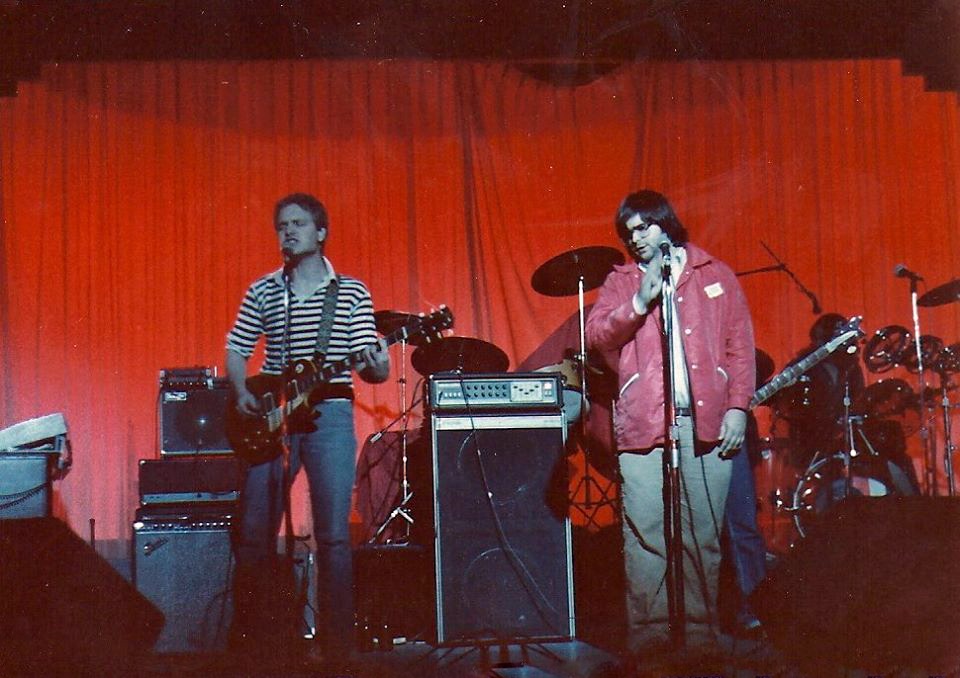
David Schade (left) and David M. of No Fun at the Cave, November 1979. Photo courtesy of David M.
Being whatever the opposite of an egomaniac is, David M. concedes, “They were probably right, too. But then the next night, Thursday, a camera crew from CKVU shows up. Lester [Interest, recently departed No Fun supporter, writer, radio insider and occasional beat poet] had booked this. Gotta give him all the credit on that—and he had contacted CKVU, and they said, ‘Yeah, we’ll come down and film your group.’ We had press clippings and stuff. So they’re like, ‘Okay, this new wave thing is happening now, and they’re playing at the Cave!’ They had no interest whatsoever in Street Player. Like, the camera crew shows up, and they’re like, ‘Oh, a camera crew, great,’ and then they realize, you could tell: The camera crew were there to film us. They’re filming us, and you could see [Street Player’s] life just draining away as they realize that, y’know, there was no interest in their really good R&B band from this camera crew. They had come for this thing that they didn’t fully understand…”
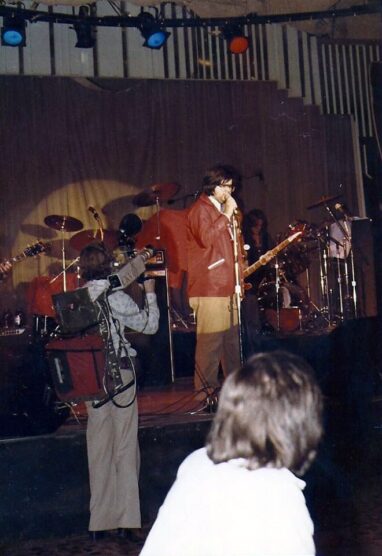
No Fun meets the press at the Cave in November 1979. Photo courtesy of David M.
The Pointed Sticks, the Beatles, and the end of the road ahead
While No Fun might have been an odd fit for the Cave—and wasn’t a well-attended show, David M. confides—some of the gambles the Cave took with newer music, as the club neared the end of its life, actually paid off. It booked the Pointed Sticks at least three times, for example, including a gig that fell, horribly, on the day that John Lennon was murdered: December 8, 1980. Which brings us to an obvious question: were the Pointed Sticks Beatles fans?
“Are you kidding?” vocalist Nick Jones says affably when I call him in Nanaimo. “Oh, my God! Punk rock may have been an influence for us, but the Pointed Sticks, when it comes down to it, are a ’60s AM radio band. Like, probably Herman’s Hermits were just as important to us as the Clash and the Sex Pistols were. The Beatles, the Stones, the Who, the Yardbirds, anything from the ’60s—including some of the American bands too, but the British Invasion, that was our thing. The Kinks, as well, obviously!”
Like his friend Bev Davies, Jones is more a fan of the early Beatles than the late. “For me, the Beatles—anything after Rubber Soul, or maybe Revolver is pretty spotty. There’s easily as much crap as there is good stuff; I don’t like their experimental stuff that much. I like the three-minute songs they wrote on their first three albums more than anything else. That’s the music that informs the Pointed Sticks, to this day: if you can’t say it in three minutes…”
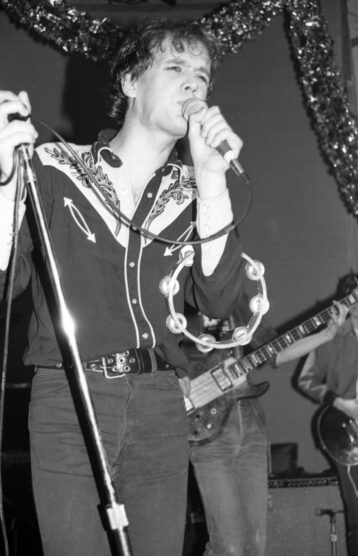
Nick Jones and his long-lost cowboy shirt, at the Cave, December 8, 1980. Photo by Bev Davies.
The Pointed Sticks had played the Cave “at least twice, and possibly three times before” that dark day in December, Jones recalls. He also is sure they were “absolutely the first” band associated with Vancouver punk to play the venue—with the first show taking place sometime between April and May of 1979, in a gig lined up by a budget agency in North Van called Compo and Associates.
“They weren’t the Bruce Allen/Sam Feldman kind of agency; they were at least one, and possibly three or four rungs down the ladder. But there was a guy named John Owen, a super nice guy, and he was our manager before Steve Macklam became our manager. He’s the one who got us into the Cave. And we had this other Compo band, Dick Twacy—they were sort of a new wave cover band, playing songs by the Cars and the Police. Nice guys, but not very good. That was the first time we played there, and Stan Grozina, the final owner of the Cave, he really liked us. And so he had us back there at least one more time” before Lennon’s assassination.
That second Cave gig “might have been ’79, but I think it was ’80,” Jones says. The Modernettes and the Dishrags shared the bill one night each, and then for the weekend, the openers were “the Modern Minds, which was Moe Berg’s band, pre the Pursuit of Happiness. I remember the place being packed, with lineups for the Friday and Saturday night and a full house for the other nights. That was kind of when we were at our peak as a draw in Vancouver. We were going to be the next big thing, the Golden Child, and of course, everyone wants to see the next big thing when they’re coming along. And our audience was about 75 per cent girls at that point; no one in the band ever complained about that, I tell you!”
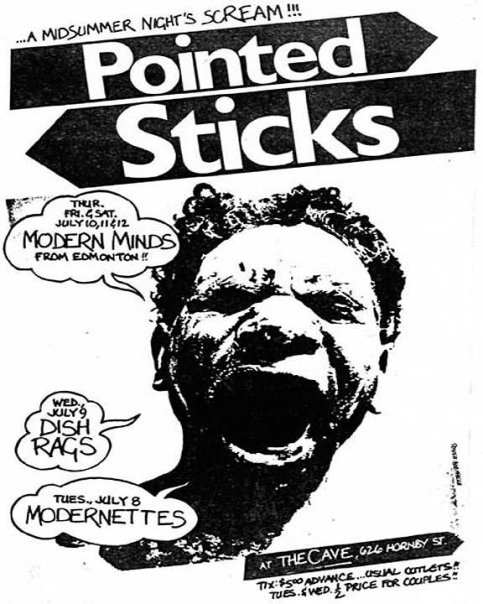
Pointed Sticks gig poster and ticket, provided by Nick Jones.
If that was the peak for the Pointed Sticks, the nadir was just around the corner. The band—one of whose early singles had come out on U.K. label Stiff Records—flew to England to record a whole album, which ended up falling apart, and the disappointment soured the group on continuing much further. By December 1980, Tony Bardach, the bassist, had been replaced by Scott Watson, whom you see behind Jones in Bev Davies’ photo. And the band had to make do with an independent Vancouver label, Quintessence, for their first LP, instead of the much more prestigious, and better distributed, Stiff Records.
On the day of the December 8 gig at the Cave, Jones recalls, “Perfect Youth had just come out. We promoted the album that very day with an appearance on The Vancouver Show. And we had played our song, or two songs, and then they cut away to Wayne Cox talking to [music journalist] Tom Harrison, going, ‘Tom, we just got news from New York; John Lennon has been shot and killed. Care to comment?” And he stuck the microphone in Tom’s face, which was a really unfair thing to do. And Tom just kind of gasped and didn’t really know what to say—really, what do you say, right? And they cut away.
“All of us were desperately shocked. We’d already sound-checked at the Cave that afternoon, and we went to Gord’s [Pointed Sticks keyboard player Gord Nicholl] house and got really drunk before we played. It probably wasn’t our best performance, but I do remember Gord giving a 10-minute drunken monologue on John Lennon and the world and various other things. That was a bad time for the band,” Jones remembers. “We were two months away from breaking up.”
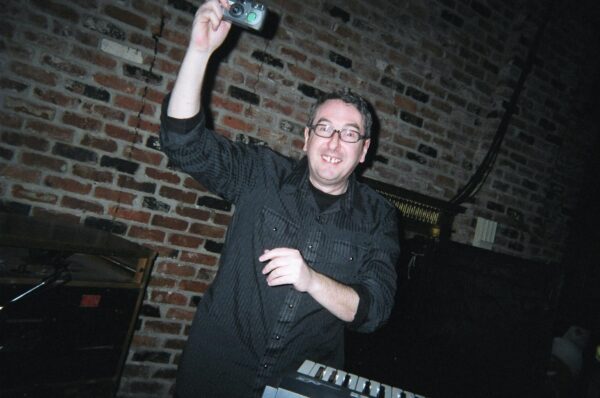
Gord Nicholl at the Pointed Sticks 2006 Vancouver homecoming concert at Richard’s on Richards. Photo by Nick Jones.
The Pointed Sticks would, of course, eventually reunite for a Japanese tour in 2006, and have, since that time, released two LPs’ worth of new material and played shows in New York and Europe. As for Jones’ most memorable nights at the Cave watching other performers, he too points to James Brown.
”The best night I ever had at the Cave was one night we went to see Iggy at the Commodore, probably on the Zombie Birdhouse tour, and after Iggy finished, we went over and saw the midnight show for the James Brown band. The Godfather of Punk and the Godfather of Funk, on the same night—probably the single greatest night of music I ever saw in my life.”
D.O.A is shown the Cave door
Just because the Pointed Sticks found their way into Stan Grozina’s heart, it doesn’t mean every punk band did. Before No Fun, before the Pointed Sticks, around the time of their very first single, D.O.A’.s Joey Keithley—known back then as Joey Shithead, though he has retired that name since getting elected to Burnaby city council—brought a tape to the Cave for an audition.
D.O.A. is pretty much undeniably the most successful band to have emerged from the late ’70s Vancouver punk scene. It has had the longest run—over 40 years now, give or take a few years off now and then. Its second LP, Hardcore ’81, gave rise to a new genre of music (or at least gave it its name), which is part of the reason it won last year’s Polaris Heritage Prize, and the reason it’s the only Canadian punk band to have a place in the American Hardcore documentary. It has toured all over the world, including gigs across Europe and Asia, and two tours of China‚—and has survived countless membership changes and deaths. But back in 1978, the one time it tried to get on a bill at the Cave, Stan Grozina proved a hard sell.
“Obviously, when I was a kid, the Cave was a place of legend,” Keithley says. “All the jazz greats played there, and singers and various nightclub entertainers and people like Eartha Kitt. I had never been in there, but it had the biggest reputation in town besides the Commodore.”
He still remembers his first meeting with Grozina. “I got in there, and I was amazed at the ceiling, because it was like a cave, obviously, and Stan was dressed up like there was a disco going on that night. There probably was—this would be 1978. I said, ‘Hi, I’m Joe. I have a band’—there was just the two of us in there, in the daytime—and he was like, ‘Let’s hear what it sounds like.’ So he fires up the sound system, which was big, and stuck in this cassette, which was ‘Disco Sucks.’ It starts out RAUUGGH, and after maybe 35 seconds through it, he heard the chorus and pulled the faders on the giant board down to zero, handed me the cassette, and said, ‘You know, you guys might want to try disco. That’s pretty popular right now!’ And he kicked me out.”
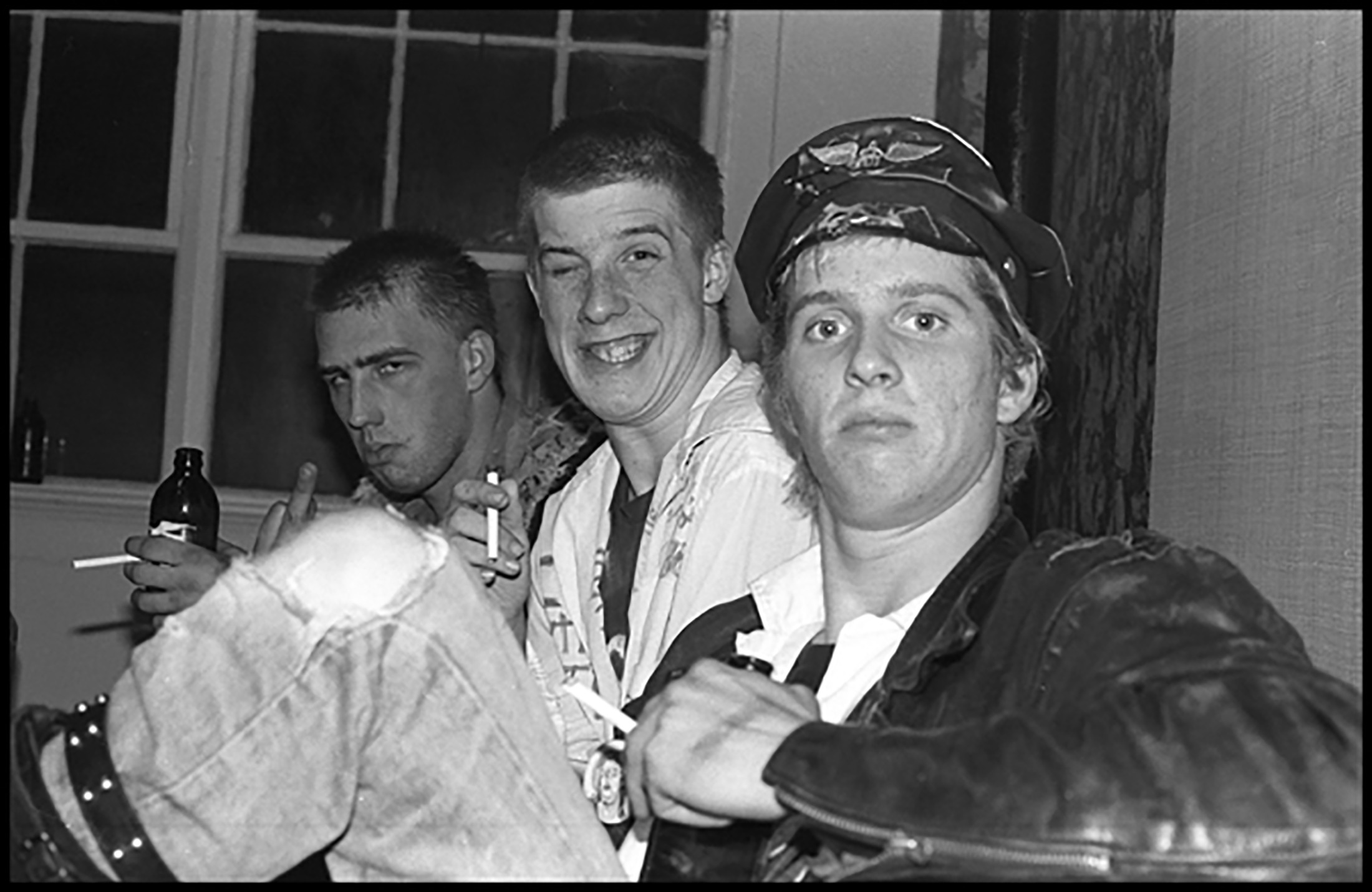
D.O.A. (from left) Joey Keithley, Chuck Biscuits, the late Randy Rampage, backstage at O’Hara’s, May 10, 1979. Photo by Bev Davies.
Read more stories of Hidden Vancouver.

